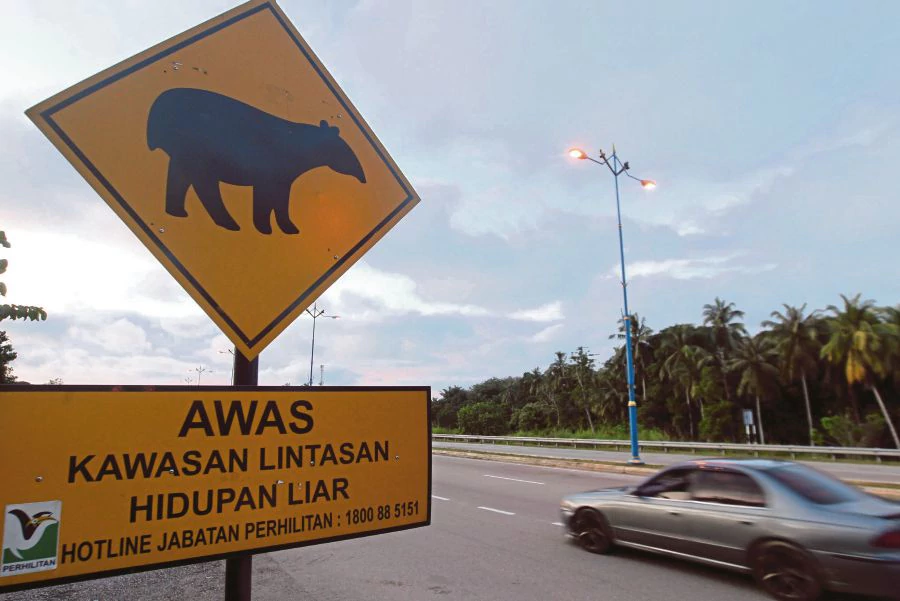ON Dec 25, the New Straits Times reported the heartbreaking death of an adult Malayan sun bear, struck by a motorcyclist around dusk on an expressway near Kuala Dungun.
Known scientifically as Helarctos malayanus (sometimes also known as the “dog bear” due to its small size, short snout and ears, and short, glossy fur), it was simply trying to cross a road. Sadly, news about roadkill — animals killed by vehicles — is growing more common.
Roads alter and isolate animal habitats and populations, deterring movement and resulting in extensive mortality. To be sure, roadkill is not unique to Malaysia. It is a global aberration, a consequence of human encroachment on animal habitats in the name of development.
About 2,100 animals were killed in traffic accidents in the past five years, according to a recent report quoting Deputy Natural Resources and Environment Minister Datuk Dr Hamim Samuri, mostly endangered species such as tapirs, sun bears, elephants, mountain goats and tigers.
“Most of the accidents occurred because the animals were trying to cross roads or highways to find shelter, food, mates and habitats,” he said. He advised motorists to be careful and pay attention when driving near forests.
At the rate these animals are being killed due to human callousness, more than advice is needed. A more comprehensive plan to prevent roadkill must be considered in the context of the National Policy on Biological Diversity, launched by Prime Minister Datuk Seri Najib Razak two years ago during the opening ceremony of the fourth meeting of the Intergovernmental Science-Policy Platform on Biodiversity and Ecosystem Services in Kuala Lumpur.
As recently suggested by Malay-sian Nature Society president Henry Goh, “a concerted effort, involving government agencies and departments, namely the
Department of Wildlife and National Parks (Perhilitan), the Forestry Department, police and the Attorney-General’s Chambers, is vital to find a long-term solution to the issue”.
The number of mammals, birds, reptiles, amphibians, invertebrates and other animals killed by vehicles each day is hard to imagine. The official roadkill numbers in Malaysia surely underestimate the true toll.
Widely reported insurance industry statistics, for example, reveal that United States drivers hit an estimated one million to two million animals every year, the equivalent of a collision every 26 seconds. Note that those are just the incidents reported for insurance purposes, usually involving a large animal and serious vehicle damage. Uncounted are the millions of smaller animals crushed by tyres or hit by windshields.
European authorities estimate that as many as 27 million birds are killed by vehicles each year. A Brazilian study estimates 1.3 million animals die every day under cars and trucks.
The effectiveness of some well-known measures to reduce roadkill has been widely documented. These include animal bridges or tunnels — viaducts for animals to safely cross over or under highways — and other human-made barriers. A recent Canadian tunnel and fencing project reduced by 89 and 28 per cent respectively the number of turtles and snakes venturing onto a road in a Unesco World Biosphere Reserve. Other helpful innovations include solar-powered alert panels that line a highway and help nighttime drivers see animals more easily.
Our authorities are certainly aware of the problem. Just last February, Natural Resources and Environment Minister Datuk Seri Dr Wan Junaidi Tuanku Jaafar directed Perhilitan and the Forestry Department to step up surveillance and preventive measures along highways and roads identified as hotspots for animal crossing. Identified now are 126 roadkill hotspots nationwide, with plans by the ministry to build viaducts at 37 hotspots to facilitate the movement of animals. This is an encouraging start.
Ultimately, however, the rakyat must take collective responsibility. We cannot leave it to the government or “nature champions” like Henry Goh or Datuk Dr Dionysius Sharma, chief executive officer of WWF Malaysia, who rightly opined that Malaysia has failed to sufficiently protect its fauna. A paradigm shift in attitudes is needed immediately.
FIRST, we must accept the right of fauna to coexist with humans. This is not to say that we should regard them as domesticates, but rather that we develop a healthy respect for their continuous survival in this country, one of the most biodiverse areas on Earth;
SECOND, the term “wildlife” or “wild animals” (binatang liar or worse, binatang buas in Malay) has threatening, human-unfriendly connotations. Let’s simply refer to our fauna as animals or haiwan; and,
FINALLY, and most importantly, our deference to animals that find their way onto our roads and highways must be at the same level we would accord a child crossing the street on the way to and from school. Then, and only then, can roadkill be reduced or prevented altogether.
Tan Sri Dr Zakri Abdul Hamid is the science adviser to the prime minister and joint recipient of the 2015 Merdeka Award (Environment). He can be reached via zakri@pmo.gov.my and Twitter: @zakriZAH. News Straits Times.
Retrieved from https://www.nst.com.my/opinion/columnists/2018/01/322831/when-will-animals-get-right-way

